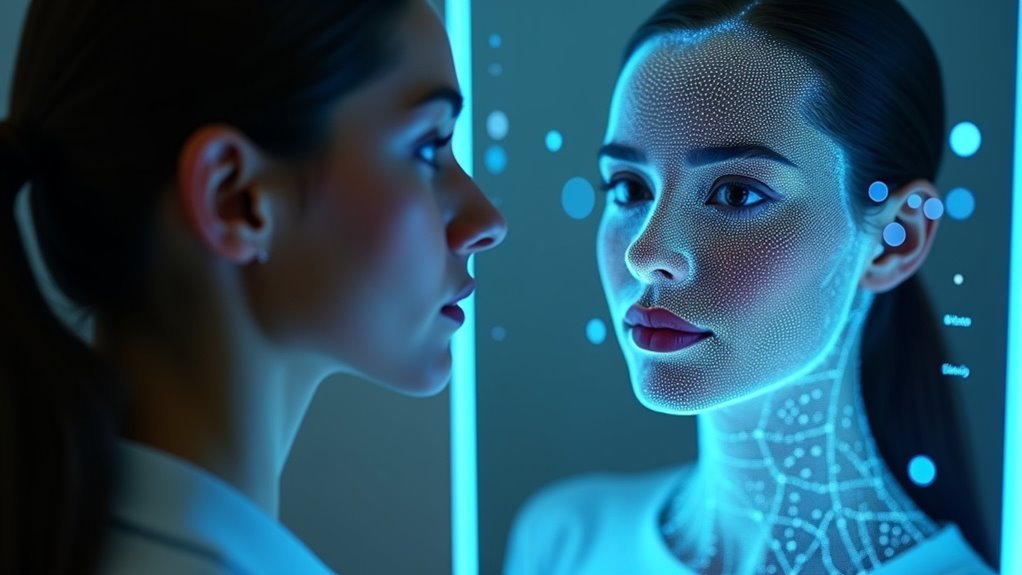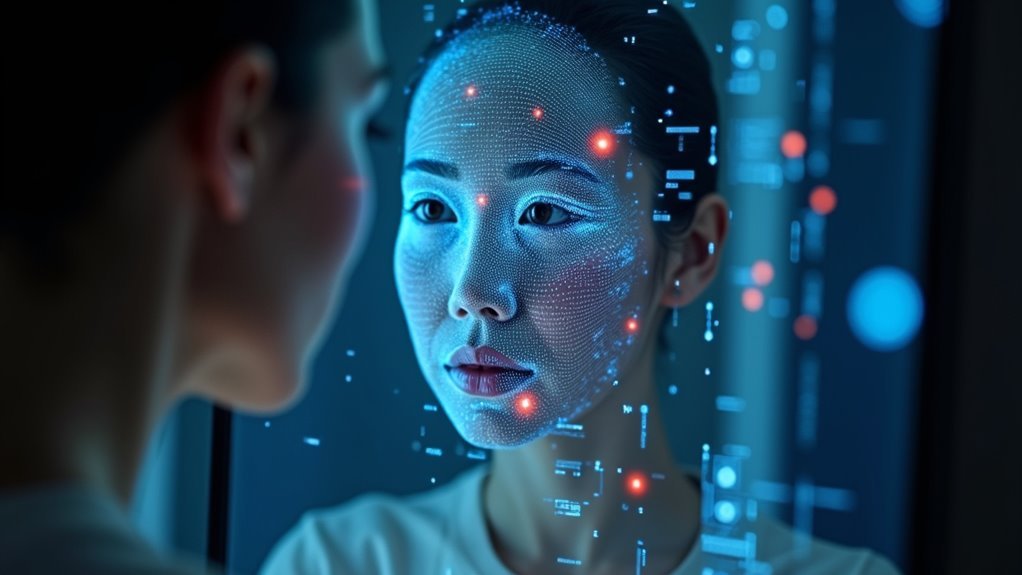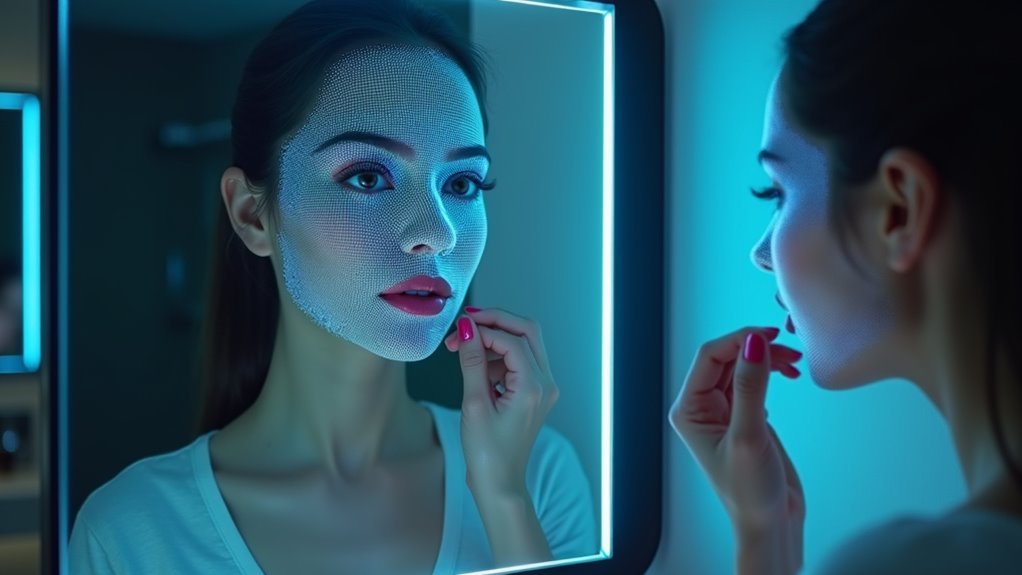You’ve probably noticed how technology keeps making everyday objects smarter, and mirrors are no exception. When you add facial recognition to mirror technology, you’re not just getting a reflective surface—you’re creating an intelligent system that knows who you are the moment you step in front of it. This recognition capability unveils a world of personalized experiences that’ll change how you interact with your reflection forever.
The Evolution of Smart Mirror Technology Through Facial Recognition

While traditional mirrors simply reflected your appearance, today’s smart mirrors powered by facial recognition technology transform how you interact with your reflection.
You’re no longer limited to passive viewing – these advanced systems actively analyze your facial features to deliver personalized experiences tailored specifically to you.
Smart mirrors now actively engage with users, analyzing facial features to create truly personalized, interactive experiences beyond simple reflection.
When you approach a facial recognition-enabled smart mirror, it instantly identifies you and recalls your stored preferences. You can virtually try on different hairstyles, makeup looks, and accessories in real-time, seeing exactly how they’ll complement your unique features before making any purchases.
The technology creates customized product recommendations based on your facial characteristics and shopping history.
This evolution has revolutionized retail environments, with studies showing 90% sales increases when customers engage with these AR-powered mirrors, fundamentally changing how you shop and interact with beauty products.
How Facial Recognition Transforms Traditional Mirrors Into Interactive Displays
The transformation occurs through sophisticated algorithms that instantly map your facial geometry when you step in front of the mirror.
Facial recognition creates your unique digital profile, enabling the mirror to deliver personalized experiences tailored specifically to you.
Here’s how this technology revolutionizes your mirror experience:
- Real-time customization – The mirror analyzes your facial features and provides instant makeup or hairstyle suggestions that complement your structure.
- Smart product matching – Advanced algorithms assess your skin tone and facial dimensions to recommend products that’ll actually work for you.
- Seamless profile storage – Your preferences are saved automatically, so the mirror recognizes you immediately during future visits.
This facial recognition integration transforms static mirrors into dynamic, interactive displays that understand your needs and adapt accordingly, creating an engaging shopping experience.
Personalized User Experiences With Facial Detection Capabilities

Beyond basic recognition, facial detection technology creates deeply personalized experiences that adapt to your unique characteristics and evolving preferences.
Smart mirrors map your facial features to deliver personalized recommendations for hairstyles, makeup, and skincare products tailored specifically to you. This individualized approach transforms your shopping experience by providing styling tips that complement your natural features.
You’ll benefit from considerably reduced return rates since these targeted suggestions help you make informed purchase decisions. The technology boosts conversion rates by up to 90% because you feel more confident in your selections.
As AI and machine learning continue advancing, you can expect increasingly accurate visualizations that create immersive shopping experiences, making every interaction with your smart mirror more valuable and relevant to your personal style needs.
Enhanced Security Features in Smart Mirror Systems
As facial recognition technology advances, smart mirror systems now offer robust security features that protect your personal information while controlling access to customized experiences.
These sophisticated systems verify your identity before granting access to personal data, preferences, and recommendations.
Enhanced security features include:
- Identity Verification – Advanced algorithms quickly match your face to stored profiles, preventing unauthorized access to your personalized settings and sensitive information.
- Threat Detection – Smart mirrors can alert retail staff when they detect potential security risks or unauthorized usage attempts in real-time.
- Profile Protection – Only verified users can access tailored experiences and personal consultations, ensuring your data remains secure.
This recognition technology aligns with growing smart security market trends, delivering both personalization and protection.
Real-Time Data Processing and User Identification

When you look into a smart mirror equipped with facial recognition technology, sophisticated algorithms instantly scan and map your unique facial features to create a distinctive faceprint. This process happens in milliseconds, comparing your faceprint against stored databases to identify you immediately.
| Processing Stage | Time Required | Function |
|---|---|---|
| Face Scanning | <1 second | Maps facial features |
| Database Search | <0.5 seconds | Compares faceprints |
| Profile Loading | <0.3 seconds | Retrieves preferences |
Real-time data processing enables the mirror to adapt your profile continuously. As your appearance changes or preferences evolve, the system updates instantly. This technology enhances customer engagement by delivering personalized product recommendations based on your history and current needs, resulting in higher conversion rates and fewer returns.
Customizable Settings Based on Individual Recognition Profiles
Once the smart mirror identifies you through facial recognition, it instantly loads your personalized profile and adjusts every setting to match your preferences. This seamless integration creates an experience that’s uniquely yours every time you approach the mirror.
Your customizable settings adapt through sophisticated algorithms that continuously update your profile. The system remembers everything from your preferred lighting intensity to your favorite product categories, ensuring each interaction feels tailored specifically for you.
Here’s what makes these profiles so powerful:
- Automatic lighting adjustments based on your previous sessions and current appearance
- Personalized product recommendations that reflect your shopping history and style preferences
- Adaptive interface changes that accommodate updates to your look, including new hairstyles or makeup choices
You’ll never need manual input again—everything loads instantly upon recognition.
Integration With Home Automation and Iot Devices
When you step in front of your smart mirror, facial recognition instantly connects with your home’s IoT ecosystem to create a seamlessly automated environment.
Your mirror communicates with thermostats, lighting systems, and other connected devices to adjust settings according to your personal preferences without any manual input.
This integration transforms your daily routine by enabling your home to anticipate and respond to your needs through a single recognition point.
Smart Home Device Connectivity
As smart mirrors connect with your home’s automation ecosystem, they transform into central command hubs that let you control everything from lighting to security systems with a simple touch or voice command.
Through facial recognition technology analyzing your facial features, these mirrors customize your entire home experience based on your individual preferences.
Your smart mirror’s connectivity enables three powerful capabilities:
- Real-time notifications – Receive weather updates, calendar appointments, and security alerts directly on your mirror display.
- Hands-free control – Use voice commands to adjust thermostats, dim lights, or activate security systems while getting ready.
- Personalized automation – Automatically trigger preferred lighting, music, and temperature settings when you’re recognized.
With smart home adoption expected to reach 70% of households by 2025, connected mirror technology is becoming essential for modern living.
Automated Personalization Through IoT
Beyond basic home control, your smart mirror’s IoT integration creates a sophisticated personalization engine that learns and adapts to your daily patterns.
Through facial recognition, your mirror automatically adjusts settings based on your unique profile, syncing with your smart wardrobe to coordinate outfit suggestions with proper lighting. This seamless connectivity extends to beauty routines, where the mirror analyzes your facial features to recommend specific products while connecting with your smart home’s ambient lighting system.
Your daily routine becomes streamlined as the mirror delivers personalized reminders for skincare regimens and appointments directly through its interface.
Future advancements will enable real-time mood detection through facial recognition, automatically adjusting lighting and background music to match your preferences, creating an increasingly intuitive and responsive personal environment.
Privacy Considerations in Facial Recognition Mirror Systems
When you install a facial recognition mirror in your home, you’re often unaware of exactly what data gets collected and how it’s used.
You need clear information about what facial data the system captures, stores, and shares with third parties.
Managing your consent becomes essential since you’ll want control over who accesses your biometric information and the ability to revoke permissions when needed.
Data Collection Transparency
How clearly do companies communicate what happens to your facial data once their smart mirror scans your features?
You’ll find that transparency varies dramatically across manufacturers, with many providing vague privacy policies that don’t adequately explain data handling practices.
Without clear disclosure, you can’t make informed decisions about the technology you’re bringing into your home.
Effective data protection transparency should include:
- Clear data retention policies – How long companies store your faceprint data
- Explicit sharing agreements – Which third parties receive access to your information
- User control options – Your ability to delete, modify, or restrict data usage
When companies fail to provide thorough transparency, you’re left vulnerable to potential misuse of your sensitive biometric information, undermining trust in facial recognition mirror technology.
User Consent Management
Transparent policies mean nothing without your explicit agreement to facial recognition data collection. User consent management forms the backbone of ethical mirror technology, ensuring you’re fully informed before any facial data processing begins.
You must understand exactly how your biometric information will be stored, used, and shared within these systems. Effective consent mechanisms require clear, jargon-free explanations that detail data retention periods and third-party access.
You shouldn’t face buried consent forms or pre-checked boxes that obscure your choices. Privacy issues become manageable when you can easily withdraw consent at any time without losing access to basic mirror functions.
Public education campaigns help you make informed decisions about participating in facial recognition technologies, building trust through knowledge and empowering you to control your digital privacy.
Hardware Components Required for DIY Facial Recognition Mirrors
Building a DIY facial recognition mirror requires careful selection of several key hardware components that work together to capture, process, and display information in real-time.
You’ll need these essential components to create an effective system:
- High-resolution camera – Captures detailed facial features for accurate faceprint creation and identification
- Processing unit – A Raspberry Pi or mini PC provides the computational power to run facial recognition software algorithms efficiently
- Display screen – An LCD or LED monitor enables augmented reality features and user interface presentation
You’ll also require storage solutions like SSDs or cloud-based systems to securely save facial profiles while ensuring quick access.
Additional peripherals including microphones and speakers enhance user interaction through voice commands and feedback.
The right hardware and software combination creates an immersive experience that transforms ordinary mirrors into intelligent recognition systems.
Software Solutions and Programming for Smart Mirror Development
While hardware provides the foundation, software development transforms your smart mirror into an intelligent system capable of recognizing faces and delivering personalized experiences. You’ll primarily use Python and JavaScript to build interactive interfaces, leveraging OpenCV libraries for facial recognition processing. Machine learning algorithms continuously improve accuracy by learning from your interactions and refining personalized suggestions.
| Component | Technology | Purpose |
|---|---|---|
| Facial Recognition | OpenCV + ML | User identification |
| Interface | JavaScript | Interactive display |
| Backend | Python | Data processing |
| Cloud Integration | APIs | Secure data storage |
| E-commerce | Platform APIs | Shopping features |
Cloud computing services securely store and analyze your data while enabling real-time updates. API integrations connect to e-commerce platforms, providing seamless transactions and augmented reality try-on features that enhance your personalized shopping experience.
Installation and Calibration of Facial Recognition Systems
Once you’ve developed the software framework, installing facial recognition hardware requires precise camera positioning to capture clear facial data from multiple angles.
Strategic placement guarantees ideal identification accuracy across varying conditions.
Strategic positioning ensures optimal facial recognition performance under diverse environmental conditions and varying user scenarios.
The calibration process involves three critical steps:
- Algorithm adjustment – You’ll fine-tune recognition algorithms to work effectively under different lighting conditions and facial orientations.
- Database creation – You’ll build a diverse facial image database that represents various ethnicities to minimize misidentification risks.
- Staff training – You’ll provide thorough training for proper operation and troubleshooting procedures.
Regular software updates maintain your facial recognition system’s accuracy by incorporating AI advancements and addressing security vulnerabilities.
This ongoing maintenance guarantees your smart mirror delivers consistent performance while maximizing user experience and maintaining robust security protocols throughout its operational lifetime.
Troubleshooting Common Issues in DIY Smart Mirror Projects
When you’re building a DIY smart mirror with facial recognition, you’ll likely encounter hardware integration problems that prevent your camera module from communicating properly with your facial recognition software.
Software calibration errors can also frustrate your progress, especially when the system can’t accurately detect faces under varying lighting conditions or fails to recognize users consistently.
These issues often stem from incompatible components, incorrect camera positioning, or outdated algorithms that need immediate attention to get your smart mirror functioning effectively.
Hardware Integration Problems
Although DIY smart mirror projects offer exciting possibilities for home automation, you’ll likely encounter hardware integration challenges that can frustrate even experienced makers. Compatibility problems between components like mirror displays, Raspberry Pi boards, and facial recognition cameras represent the most common obstacles you’ll face.
Here’s how to tackle these integration issues:
- Select compatible components – Research compatibility between your mirror display, Raspberry Pi model, and camera modules before purchasing to avoid connection problems.
- Verify power requirements – Confirm your power supply meets the voltage and current demands of all components, as inadequate power causes performance issues and system instability.
- Check connections systematically – Verify HDMI connections and configure display settings properly within your operating system to prevent display malfunctions.
Software Calibration Errors
Software calibration errors can derail your smart mirror project faster than hardware failures, transforming what should be a seamless user experience into a frustrating series of glitches and unresponsive commands.
You’ll encounter these issues primarily through incorrect operating system installation, which creates display problems and interface failures. Mismatched resolution settings between your software and display panel will produce pixelated, distorted images that compromise functionality.
Don’t overlook software updates—outdated firmware frequently causes performance issues that proper calibration can’t fix.
You’ll also face touchscreen problems when overlay alignment doesn’t match your display precisely, requiring careful measurements during installation.
Most critically, verify hardware-software compatibility before setup. Incompatible components generate persistent software calibration errors that’ll plague your project’s performance regardless of other optimization efforts.
Cost Analysis and Budget Planning for Facial Recognition Upgrades
Since facial recognition mirror technology requires significant upfront investment, you’ll need to develop an extensive budget that extends beyond initial hardware costs. Your cost analysis should encompass high-quality cameras and software that can reach tens of thousands of dollars depending on deployment scale.
Facial recognition mirror implementation demands comprehensive budget planning that accounts for substantial hardware, software, and ongoing operational expenses beyond initial purchase costs.
Essential budget planning considerations include:
- Ongoing maintenance and updates – Add 15-20% annually for software updates and system accuracy
- Compliance investments – Secure data storage solutions and legal consultations for privacy law adherence
- Employee training programs – Staff education on ethical facial recognition use and privacy management
You’ll find the investment worthwhile, as retailers report up to 30% increases in customer engagement and sales.
Your budget planning must balance initial costs with long-term ROI potential while ensuring regulatory compliance.
Future Applications and Technological Advancements in Smart Mirrors
You’ll witness smart mirrors evolving beyond retail as AI integration advances transform them into sophisticated health monitoring devices that can detect early signs of illness through facial analysis.
Healthcare mirror applications will revolutionize your daily routine by tracking essential signs, skin conditions, and even mental health indicators through micro-expression recognition.
WebAR mirror technology will eliminate the need for specialized apps, allowing you to access augmented reality features directly through your browser for seamless virtual try-on experiences.
AI Integration Advances
As artificial intelligence continues to evolve at breakneck speed, smart mirrors are becoming increasingly sophisticated in their ability to understand and respond to your unique preferences.
Facial recognition technology now creates detailed user profiles that transform how you interact with these devices.
AI integration advances are revolutionizing smart mirror capabilities through:
- Advanced algorithms that analyze your facial features for personalized product recommendations and virtual try-ons
- Real-time feedback systems that provide styling tips and adapt to your behavior patterns
- Machine learning enhancements that deliver increasingly realistic visualizations and seamless interactions
Healthcare Mirror Applications
The technology that’s transforming your daily beauty routine is now making unprecedented strides in healthcare settings. Smart mirrors equipped with facial recognition technology can analyze your facial features to detect dehydration, fatigue, and other health indicators in real-time. You’ll benefit from seamless telemedicine integration that enables virtual consultations where providers can visually assess your condition remotely.
| Healthcare Application | Current Capability | Future Advancement |
|---|---|---|
| Health Assessment | Facial feature analysis for dehydration/fatigue | AI-driven essential sign monitoring |
| Patient Consultation | Telemedicine platform integration | Enhanced remote diagnostic capabilities |
| Rehabilitation Support | Interactive exercise feedback | Personalized treatment plan optimization |
Future developments will include non-invasive monitoring of your heart rate and blood pressure through advanced facial recognition analysis, revolutionizing patient-centered care delivery.
WebAR Mirror Technology
While traditional smart mirrors require dedicated applications, WebAR mirror technology revolutionizes accessibility by letting you instantly access augmented reality experiences through simple QR codes or web links.
This breakthrough combines advanced facial recognition capabilities with seamless web integration, creating personalized shopping experiences that map your unique features for tailored product recommendations.
WebAR mirror technology transforms your shopping experience through:
- Real-time virtual try-ons – Visualize clothing, makeup, and accessories without physical interaction
- Instant accessibility – No app downloads required, just scan and experience
- Personalized suggestions – Facial recognition analyzes your features for customized recommendations
Studies show AR experiences increase conversion rates by up to 94%.
Future developments will integrate AI and machine learning for ultra-realistic visualizations across fashion, beauty, and automotive sectors.
Frequently Asked Questions
What Is the Technology Behind Facial Recognition?
Facial recognition technology captures your face through digital cameras, then maps your unique features using sophisticated algorithms. It creates a distinct faceprint that’s compared against stored database profiles for quick identification.
What Is the Technology Behind Smart Mirrors?
You’ll find smart mirrors use AI processors, cameras, and display screens embedded behind reflective glass. They’re powered by gesture recognition sensors, facial tracking algorithms, and real-time image processing software that overlays digital content seamlessly.
How Does Facial Recognition Improve Security?
Facial recognition improves your security by creating unique faceprints that verify your identity instantly. You’ll experience faster access while unauthorized individuals can’t breach your systems, reducing fraud incidents and protecting your sensitive information effectively.
What Are the Disadvantages of Facial Recognition?
You’ll face misidentification risks from appearance changes, privacy concerns from constant surveillance, inconsistent performance in poor lighting, high data storage costs, and expensive upfront installation expenses that can deter adoption.





Leave a Reply